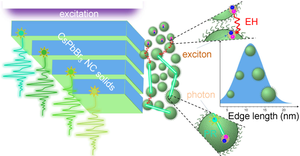Universal, predominant exciton transfer in perovskite nanocrystal solids
Abstract
Perovskite nanocrystal (PNC) solids are promising materials for optoelectronic applications. Recent studies have shown that exciton diffusion in PNC solids occurs via alternate exciton hopping (EH) and photon recycling (PR). The energy disorder induced by the size distribution is a common factor in PNC solids, and the impact of this energy disorder on the exciton diffusion remains unclear. Here, we investigated the exciton diffusion in CsPbBr3 NC solids with a Gaussian size distribution of 11.2 ± 6.8 nm via steady and time-resolved photoluminescence (PL) spectroscopy with multiple detection bands in transmission mode. Our results indicated that exciton diffusion was controlled by a downhill transfer among the different energy sites through the disordered energy landscape, as confirmed by the accompanying low-temperature PL analysis. A detailed examination revealed that the acceptor distribution in tandem with the reabsorption coefficient determined the contribution of EH and PR to exciton transfer between different energy sites. Consequently, the exciton diffusion mechanism varied in PNC solids of different thicknesses: in a thin solid with a thickness of several hundred nanometers, the exciton transfer was dominated by efficient EH and PR from the high-energy sites to the lower-energy sites; in a few-micrometer-thick solid, transfer from the medium-energy sites toward the lower-energy sites also became prominent and occurred mainly through PR. These findings enhance the understanding of the vital role that the acceptor distribution plays in the exciton diffusion process in PNC solids, providing important insights for optoelectronic applications based on PNC solids. Our work also exploits the use of commonly available tools for in-depth exciton diffusion studies, which reveals the interior diffusion information that is usually hidden in surface sensitive PL imaging methods.


 求助内容:
求助内容: 应助结果提醒方式:
应助结果提醒方式:


